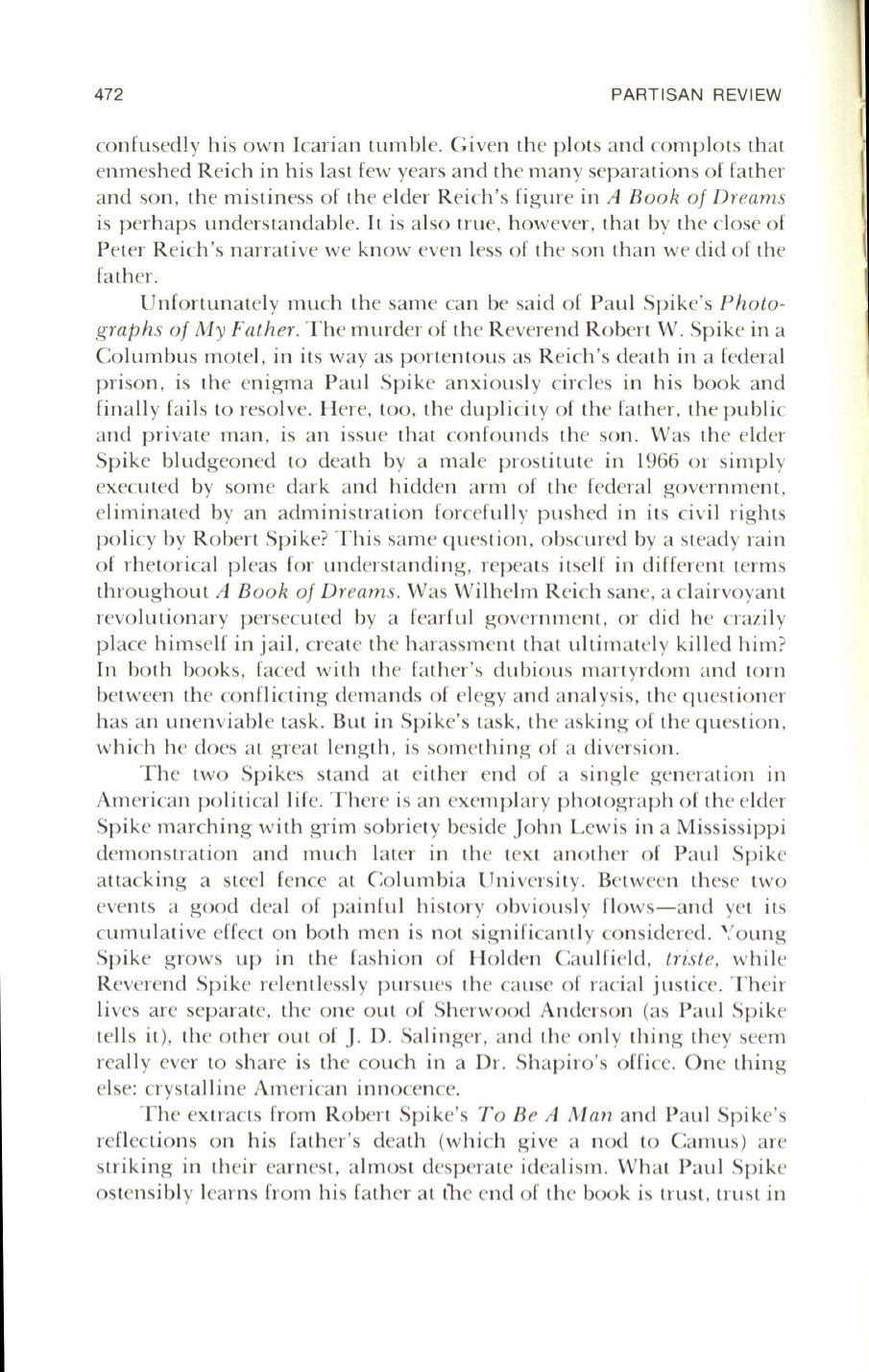
472
PARTISAN REVIEW
confusedl y hi s own Icari an tumbl e. Given the p lo ts and comp lo ts that
enmes hed Reich in hi s las t few years and th e man y separa tions o f fa th er
and son , the mi stiness of the elder Reich 's fi gure in
A Book of Dreams
is perhaps understanda bl e.
It
is a lso true, however, th a t by the close of
Peter Reich 's narra ti ve we know even less of the son than we did o f the
fa ther.
Unfo rtuna tely much the same can be sa id of Paul Spike's
Pho to–
g rap hs of
My
Father.
T he murder of the Reverend Robert W. Spike in a
Co lumbus mo tel, in its way as po rtento us as Reich 's dea th in a federal
prison , is the eni gma Paul Spike anxiously circl es in hi s book and
fin a ll y fa il s to resolve. H ere, too, the dupli city of the fa ther, th e public
and pri va te man , is an issue th a t confounds the son. Was th e elder
Spike bludgeoned to dea th by a ma le p ros titute in 1966 o r simpl y
executed by some dark and hidden arm of the federa l government ,
elimin a ted by an admini stra ti on forcefull y pushed in its civil ri ghts
po li cy by Ro bert Spike? Thi s same qu es ti on , o bscured by a steady ra in
o f rheto ri ca l pl eas for understandi ng, repea ts itself in di [[erent terms
thro ugho ut
A Book of Dreams.
Was Wilhelm Reich sane, a cl a irvoyant
revo luti onary persecuted by a fearful government , o r did he crazil y
pl ace himse lf in ja il , crea te th e harassment tha t ultima tely kill ed him?
In bo th books, faced with the fa ther 's dubi ous mart yrdom and to rn
between the conflictin g demands of elegy and ana lys is, the ques ti oner
has an unenvia bl e tas k. But in Spike's tas k, the as king o f the ques ti on ,
whi ch he does a t grea t leng th , is somethin g of a diversion.
The two Spikes stand a t either end of a single generati on in
Ameri can po liti cal life. T here is an exempl ary pho tograph o f the elder
Spike marching with grim sobriety bes ide J ohn Lewi s in a Mississ ippi
demonstra tion and much later in th e text ano ther of Paul Spike
attac king a stee l fence a t Columbia Uni versity. Between these two
events a good dea l of p a inful hi sto ry o bviously fl ows- and ye t its
cumul a tive effect on bo th men is no t signifi cantl y considered. ' : oun g
Spike g rows up in the fa shion of Holden Caulfi eld,
tris te,
whil e
Reverend Spike relentl ess ly pursues the ca use o f racia l justi ce. T heir
lives are separate, the one out of Sherwood Anderson (as Pa ul Spike
tell s it ), the o ther out of
J.
D. Salin ger, and the onl y thing they seem
rea ll y ever to sha re is the couch in a Dr. Shapiro's offi ce. One thin g
else: crys ta lline Ameri can innocence.
The extracts from Ro bert Spike's
T o Be A Man
and Paul Sp ike's
refl ections on hi s fa ther 's death (which give a nod to Camus) a re
striking in their earnes t, a lmos t des pera te ideali sm. Wha t Paul Spike
os tensibl y learns from hi s fa th er a t the end of the book is trust, tru st in


